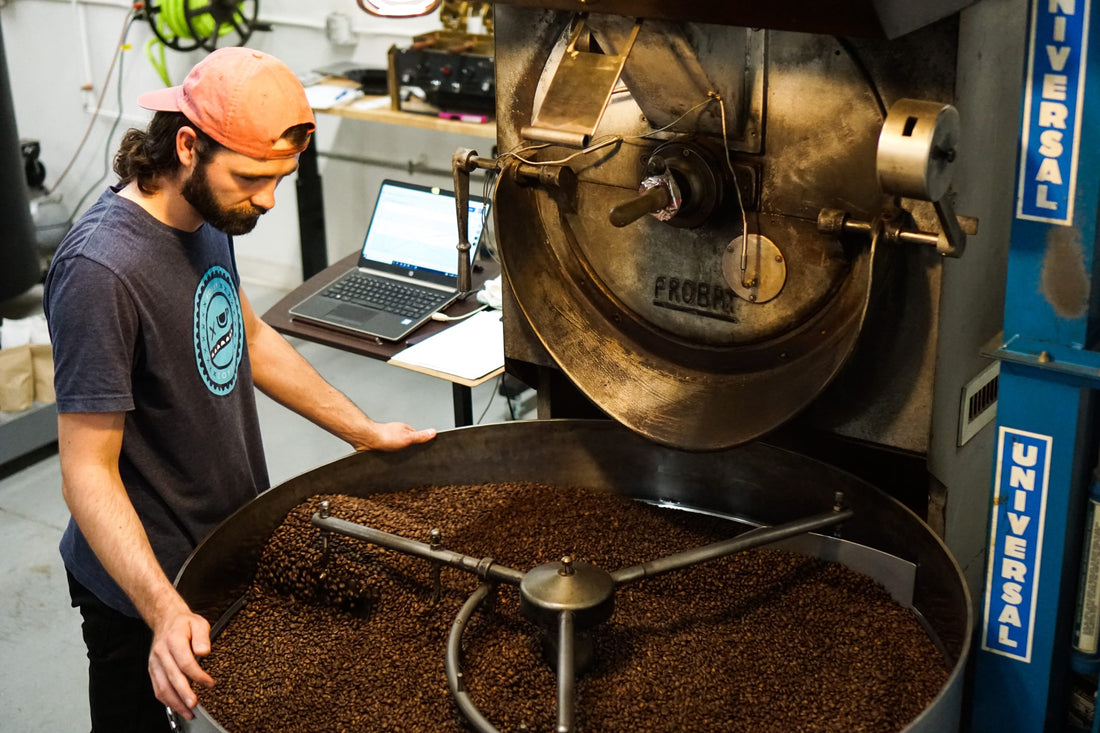In this blog post you’ll find:
- The difference between espresso beans and coffee beans
- Can you brew espresso beans like regular coffee?
- The best type of coffee beans for espresso
- What is a single origin espresso?
- Our go-to espresso recipe
Is there a difference between espresso beans and coffee beans?

The short answer is, there isn’t any difference between espresso beans and coffee beans! Labeling a coffee as “espresso” is entirely up to the coffee roaster. Let’s break it down.
There are four main types of coffee producing plants; arabica, robusta, liberica, and excelsa. Arabica plants make up the majority of coffee production in the world and produce the highest quality and best tasting coffees. Robusta plants are easier to grow, contain more caffeine, and generally produce lower quality and often bitter coffees. Liberica and excelsa are the least produced coffees each with distinct qualities and flavors. These plants are typically grown in Asia. Check out this great blog from Coffee Affection for a full breakdown. There are thousands of coffee varieties within each plant family.
So where does espresso fit in? Espresso refers to both the preparation and coffee drink. Serving espresso requires machines or manual equipment that apply 9 bar of pressure (9 times atmospheric pressure or ~130lb per square inch). This pressure pushes hot water through very finely ground coffee for rapid extraction. This creates espresso, a highly concentrated 2 ounce coffee. Due to the high concentration, espresso has the most intense flavor of all coffee brewing methods.
What type of coffee is used for espresso?
Any coffee bean can be used to create espresso. When a coffee is labeled as an “espresso”, the roaster has roasted and/or blended this coffee specifically to be served as espresso. Most espresso in the United States is served in steamed milk drinks like lattes or cappuccinos. Espresso roasts tend to have flavors that pair nicely with steamed milk, like dark chocolate, caramel, or berry flavor notes.
Traditional or old-school espressos have a dark roasted, rich, robust flavor profile. They are frequently blended with robusta to increase the body and caffeine content. There has been a movement towards 100% arabica espresso, like our SOB Espresso, due to the higher quality flavor profiles and the risk of bitterness that come with robusta coffees.
Can you brew espresso beans like regular coffee?
Yes! As outlined above, there is no difference in the beans of espresso beans and other coffees. Espresso beans can be brewed like any other coffee beans you enjoy. The differences in flavor of espresso beans brewed like regular coffee will be entirely due to the coffee roaster’s selection of coffee varieties and roasting methods. Espresso roasts tend to be more developed. As a result, you can expect brewed coffee made from espresso beans to be fuller bodied with darker flavor profiles. Once again, this varies depending on the roaster. For example, we created the SOB Espresso to combine the traditional espresso profile of dark chocolate with the brightness and sweetness of a single origin coffee (more on single origin espresso below).
The best type of coffee beans for espresso
It becomes very subjective at this point. Each roaster chooses the coffees they believe work best for espresso based on their flavor preferences and roasting philosophy. This is also true for the espresso drinker.
If you like dark, woody, charred notes, seek out dark-roasted traditional espresso. The sign of a dark-roasted coffee is oily beans. This oil only occurs on very dark roasted coffee. Longer roasts with high heat create internal shell cracking, releasing CO2, which reacts with oxygen to form oil.
If you like balanced espresso with some darker notes along with sweetness and complexity, seek out espresso roasts using 100% arabica coffee. The flavor profile will depend on the varieties of coffee used and the roasting method. Roasters provide flavor & tasting notes to give you a good idea of what to expect.
If you like bright espresso with distinct flavors, try single origin espresso.
What is single origin espresso?

If you frequent third-wave style coffee shops, you have likely seen a single origin espresso on the menu. Single origin espresso is a single origin coffee prepared as espresso. Single origin means the coffee is sourced from a single farm or region. It is not possible to describe the flavor profile of single origin espresso, because it is dependent on the coffee being used. Coffee is concentrated when served as espresso. As a result, the flavors present in the coffee are also intensified. Many single origin coffees are roasted lighter to bring out the natural flavors of the coffee without the overpowering flavors of a darker roast profile.
Fruit-forward coffees (think natural processed coffees), like our House Bean, create an espresso shot with big berry and chocolate notes. Bright and citrusy coffees, like our Winer, create an espresso shot bursting with lemon-like acidity. Depending on the coffee variety, single origin espressos are usually intended to be consumed on their own. These unique flavors sometimes do not pair well with steamed milk. Maybe that’s why we don’t see lemon milk at the grocery store? Even so, getting a latte or cappuccino with a single origin espresso can create a distinctive and delicious drink!
Our go-to espresso recipe

Creating great espresso takes practice. Dialing in espresso requires balance and consistency between the amount of coffee, grind size, and tamping pressure among other variables. Below is our go-to recipe as a starting point for any coffee:
- 17g of finely ground coffee
- 40-45g of espresso liquid
- 25-35 seconds to get to 40-45g of espresso (finer grind if it is too fast, coarser if it is too slow)
For other ways to enjoy espresso, check out our Easy Espresso Recipes and Espresso Cocktail Recipes

